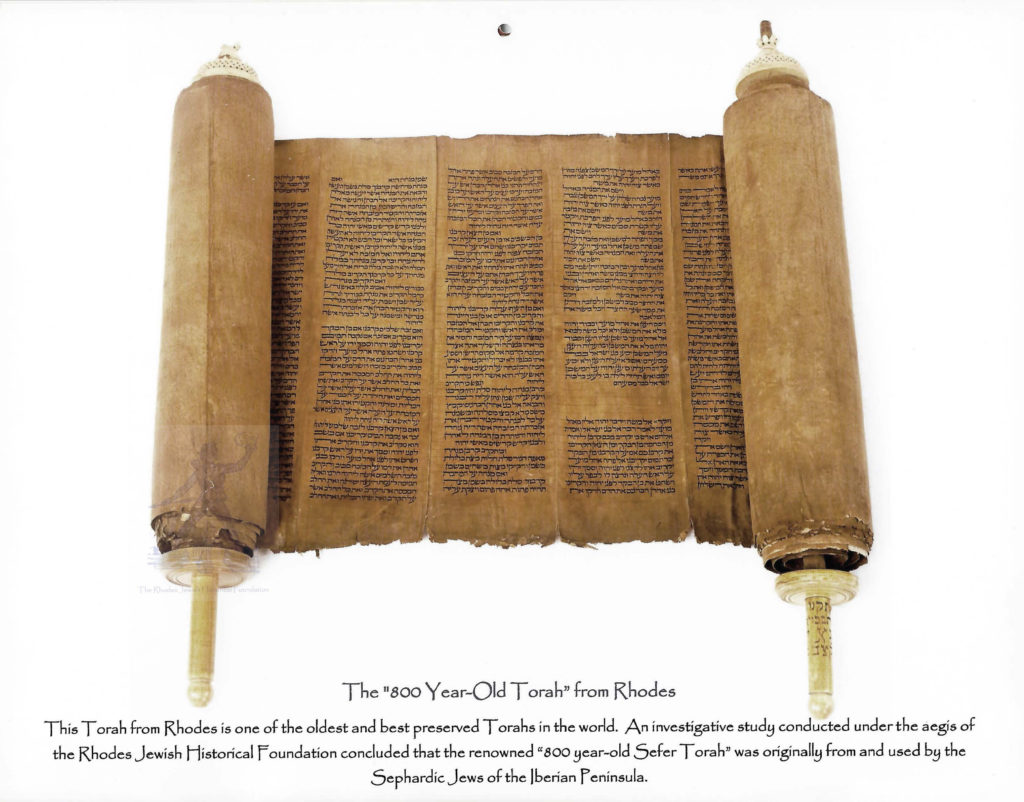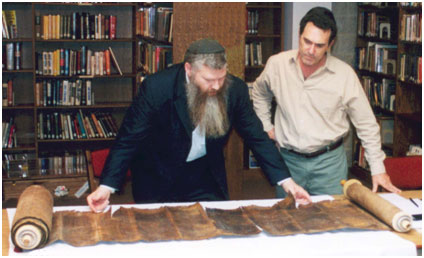“800 Year-Old Torah of Rhodes”

Featured in the Rhodesli Jewish Calendar September 2010. The Torah is in Buenos Aires, Argentina.
In 2003, the Rhodes Jewish Historical Foundation acquired a short-term permission from the Chalom Temple in Buenos Aires to exhibit and analyze the ancient Torah in the United States in order to promote the education and preservation of the Jewish history of Rhodes.
Prior to its arrival in Los Angeles, this ancient Sefer Torah was scientifically measured by the University of Buenos Aires using the Carbon-14 dating analysis and was found to be approximately 800 years-old.
In 2003 and 2004 the “800 Year-Old Torah”, which is one of the oldest Torahs in the world, was taken on exhibit around the United States. It was shown to appreciative audiences in Atlanta, Seattle and Portland and several venues around the Los Angeles area.
It was speculated that its geographic origin was from Spain from before the Spanish Inquisition. Therefore, during 2003 and 2004, a study was conducted by the Rhodes Jewish Historical Foundation focusing on the peculiarities of its ancient Judaic religious writing styles.
Featured in the Rhodesli Jewish Calendar (September 2010).This incredible Torah was viewed and analyzed by several rabbis and sofers (scribes of religious writings). Based upon several factors, it was concluded that this Torah was from the Sephardic Jews at the time of Maimonides.
An investigative study conducted under the aegis of the Rhodes Jewish Historical Foundation has concluded that the renowned “800 year-old Sefer Torah” from the Island of Rhodes was originally from and used by the Sephardic Jews of the Iberian Peninsula.
Therefore, we can imagine that this Torah was likely brought from the Iberian Peninsula to the Island of Rhodes by the Sephardic Jewish refugees when they fled Spain and Portugal.
Since 2019, the Chalom Temple has loaned the 800-year-old Sefer Torah of Rhodes to the Holocaust Museum of Buenos Aires. According to Cecilia Martinez of La Nacion, “to facilitate its exhibition to the public while complying with the safety and care requirements that an object of these characteristics requires.”
Expert Analysis Confirms “800 Year-Old” Torah From Rhodes Has Sephardic Origins
While present in Los Angeles, the Torah was analyzed by a scribe “sofer” who is an expert in evaluating the age and origin of ancient Hebrew writings. I interviewed Rabbi David Rue and selected highlights for people interested in understanding the distinguishing features of this ancient scroll. This summary of excerpts is about 10 minutes in length and is now presented for everyone to appreciate.
Examples of the Religious Writing Style of the “800 Year-Old Torah”
We have learned that there are many different indications which give clues as to a Sefer Torah’s age and Sephardic origin. The following are some of the simpler to understand examples without getting too technical:
* All modern Torahs have 42 lines per column, while the 800 year-old Torah has 45 lines per column.
* The letter “lamed” is now written with a “cap” at the top, while the 800 year-old Torah has no “cap” on top.
* The letter “yud” in the 800 year-old Torah is written with an extra point or protrusion downward from the left center of the letter.
* When the letters “nun” and “yud” are next to each other they are separate letters in new Torahs, while the 800 year-old Torah has the “nun” extend below the “yud”.
* In order to justify the margins in modern Torahs only certain letters are elongated. In the 800 year-old Torah most letters are elongated.
* The “open” spacing between the words in the 800 year-old Torah show that it follows the Sephardic style of the Rambam called “petuhot”. For the last 400 years all Torahs have been written with the “closed” style (called “stumot”).
Examples of Differences Between the Ancient and Modern Judaic Religious Writing Characteristics:
|
|
|
|
|
| “Old” nun extends under the yud. “Old” yud with extra left lower stem.“ | “New” nun, yud. New yud without extra stem. | “Old” lamed without “cap”. | “New” lamed with “cap”. |
An Example of Elongated Letters in the Ancient Torah:

Script from the Exodus portion of the 800 year-old Torah. The words were elongated in order to show even margins.
Expert Analysis of the Ancient Torah:

August 2003 in the library of the Sephardic Temple Tifereth Israel in Los Angeles, of Rabbi David Rue analyzing the Hebrew characters and spacing of the Sefer Torah with Aron Hasson observing.
Rabbi Rue is a “sofer” (scribe) with over twenty years of experience in Israel analyzing the age and origins of ancient Torahs in the museums of Jerusalem and Tel Aviv.
It was recognized that this ancient Torah did not utilize a strict alignment (justified text of the columns), instead it follows a style that has not been used for over 600 years.
The following video is an interview of Rabbi David Rue analyzing the Torah:



Do sifrei torah of this age have some or all of the englarged letters (sh’ma, etc.) that newer scrolls have?
I believe the statement about the contrast between “open” and “closed” “styles” is a misunderstanding. Every Torah has some sections that end on the same line as the next one begins (called a “closed” “parasha” (section), and some sections that end leaving the rest of the line open (called an “open” parasha). However there may be different traditions concerning which sections are to be left open and which closed. Maimonides detailed which are to be open. I presume what was intended here is that this scroll follows Maimonides’ rulings concerning which sections are to be “open”.
absolutely fascinating; how much more is waiting to be found? particularly in the Vatican??
Baruj Hashem: Felicitación por tan delicado work, investigo todo sobre los escritos antiguos y sagrados de la Toráj, El Eterno les otorgue salud, properidad para continuar en todo lo que hagan y emprendan.
An absolutely fascinating article! Some of the points made are new to me (and I am a full time sofer!). This is the first time I saw a sefer torah with lamed being written without a rosh on the vov. I invite people interested in safrus to check out my website http://www.mezuzadepot.com.